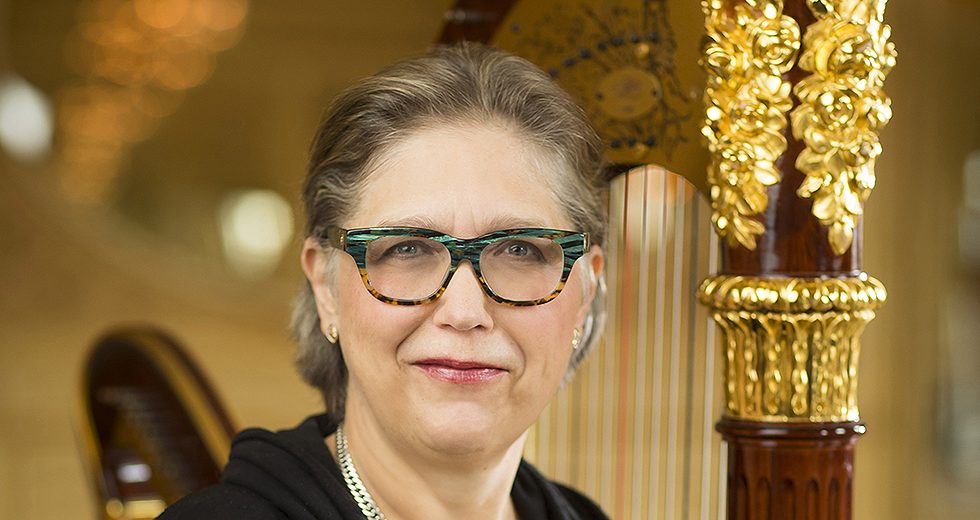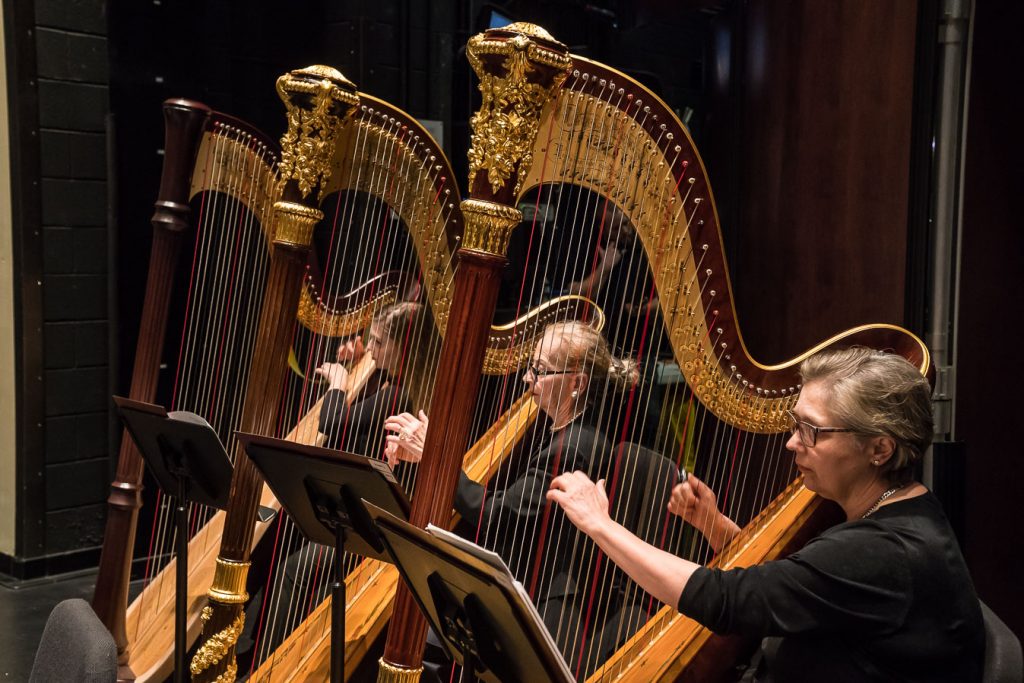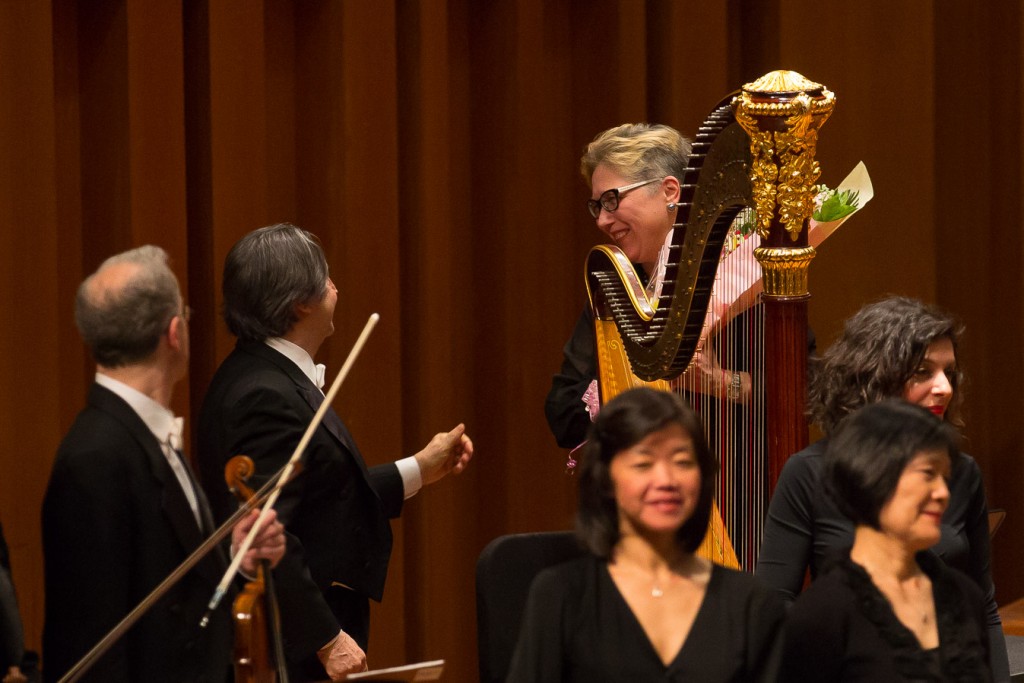
When she was about 5 years old, Sarah Bullen attended a harp recital and immediately realized it was the instrument for her. Urged on by her mother, “a fairly serious classical pianist,” young Sarah had begun piano lessons a year earlier. “[The piano] seemed so hard and bulky,” she said. “So I didn’t want that. But it wasn’t easy to find a harp teacher, and the instruments were expensive.”
Undeterred, Bullen’s mother announced three years later on her birthday that she would be starting lessons. An aunt had died and had left enough money for the purchase of a harp: about $30,000 in today’s dollars. Bullen remembers being struck by the harps lined up in the her new teacher’s studio and how she stacked up phone books so that the little girl could sit up high enough to reach the instrument’s strings. “The physical beauty of the instrument was always so awesome just to see, not to mention listening to it,” she said. “It felt totally right.”
Bullen’s love for the instrument has never flagged since. Beginning her professional career in 1981, she has served as principal harp of the Chicago Symphony Orchestra since 1997. Audiences will see her in action when she appears April 19-21 as soloist in Debussy’s Sacred and Profane Dances. “I’m an ambassador for the instrument, so I’m happy to bring it forward,” she said. “I’m proud to do that. I’m proud to have a voice.”

Stravinsky’s Scherzo fantastique requires three harps, including in this case, Julia Coronelli (from left), Lynne Turner and Sarah Bullen, as seen during a CSO tour performance at University of North Carolina’s Memorial Hall in Chapel Hill, N.C., in February. | ©Todd Rosenberg 2018
Repertoire for harp and orchestra is limited, and Bullen regards this well-known work, which premiered in Paris in 1904 with Lucille Wurmser-Delcourt as soloist, as a masterpiece. Gustave Lyon, the head of Pleyel, Wolff & Cie., a well-known French manufacturer of music instruments, had recently debuted a new chromatic harp with 78 strings that would ultimately prove impractical. He wanted Debussy to write a short work that would display the strengths of his invention. But the composer went much further, creating not a full-fledged concerto but a nonetheless substantial one-movement work.
Although the word “profane” in English means sacrilegious or disrespectful, the French sense of the word suggests earthiness or sensuality. “The two dances, for harp with a simple string accompaniment, are spare and delicate works,” writes CSO annotator Phillip Huscher in his notes for this program. “The first is particularly austere, with solemn, modal harmonies … Manuel de Falla called the lively and atmospheric second dance one of Debussy’s Spanish pieces although it is, in fact, simply a waltz.”
After her early studies on the harp near her Long Island home, Bullen eventually enrolled at the Manhattan School of Music and studied with Marcel Grandjany, whom she called the “Pablo Casals of the harp.” For her final two years of high school, she attended the Interlochen (Mich.) Arts Academy, the prestigious arts-focused boarding school that she saw as a kind of refuge. “For me, it was like a pilgrimage going to Interlochen, because I was going there to focus on harp,” she said. “My parents were divorcing at the time — it was a difficult home situation — and it offered a good way to get away from all that and forge my own path.”
After a year at the Eastman School of Music in Rochester, N.Y., Bullen moved to the famed Juilliard School in New York, where she earned her bachelor’s degree in 1978 and master’s degree in 1979. She began her professional career two years later as principal harpist of the Utah Symphony and moved to the New York Philharmonic in 1987.
In 1997, when Eddie Druzinksy, the CSO’s principal harp for 40 years, announced he would retire, Bullen decided to audition for the post. Although she grew up on Long Island and studied in New York City, she was a big admirer of the CSO. Her esteem for the city and its orchestra began in the late 1970s, when she was a student at Interlochen and the school’s orchestra performed in Chicago as part of a Midwestern tour. “I was so blown away,” she said. “I loved the city. I grew up with New York as my focus for music education when I was child, but New York always kind of scared me for some reason. I came to Chicago, and there was something that resonated with me about this city even that age.”

Riccardo Muti presents a bouquet of flowers to Sarah Bullen, principal harp, after the Chicago Symphony Orchestra’s first concert in Beijing on its 2016 Asia Tour. | ©Todd Rosenberg Photography 2016
After she won the audition, Bullen met then-CSO music director Daniel Barenboim for the first time; to her surprise, he said that the two were already acquainted in a way. It so happened that he had been at her audition when she earned her position in the New York Philharmonic. Harp auditions are so rare that then-music director Zubin Mehta had invited Barenboim, unbeknownst to Bullen, to sit in. “He said, ‘I was there when you won,’ and he remembered me. He said, which was cute, ‘I’ve been to two harp auditions in my life, and you’ve won both of them.’”
After her arrival, the CSO purchased her a new Prince William harp from the Chicago firm of Lyon & Healy, which she calls the “Steinway of harps.” It has been crafting instruments in the same building for more than 100 years. “Harps are not like violins where you are playing a Stradivarius that is 300 years old,” Bullen said. “They don’t last as long because of the all the mechanical issues. There is a lot of tension in a harp, and it kind of pulls the wood apart. You can only fix it so many times.”
A concert harp has 47 gut and steel strings, which span more than three feet. The C strings are colored red and the F strings are tinted black. “They are there to help guide us, because it would be hard to know where you are going if you didn’t have color-coding,” she said. A big challenge is keeping all those strings in tune, and adjustments cannot be made on the fly as with some other instruments. Bullen recounted an old joke about harpists spending 50 percent of their time tuning and the other 50 percent playing out of tune. Adding to the instrument’s complexity are seven foot pedals for the seven notes of the scale, each with three different positions. The pedals are used to tighten or loosen the strings to effect sharps and flats.
If coordinating the string fingerings and pedal positions wasn’t already enough, the harpist also read the sheet music and follow the conductor at the same time. “That gets tricky,” she said. “Ideally, you want to keep your eye on a conductor, but if I’m jumping from here to there, you can’t. So you learn to keep the conductor in your peripheral vision.” Needless to say, it all requires considerable strength and dexterity.
Bullen has been generous throughout her career in helping other harpists. At the New York Philharmonic, she served as the chairwoman of the harp department at the Manhattan School of Music, and she retired in 2016 as professor of harp at Roosevelt University in Chicago. She continues to teach privately and likes to assist aspiring harpists in preparations for orchestral auditions. Her students hold positions in such ensembles as the Colorado Symphony and Lyric Opera of Chicago Orchestra.
Along with teaching, Bullen is the author of two volumes of the book, Principal Harp: A Guidebook for the Orchestral Harpist, in which she outlines harp fingerings and pedaling diagrams for the standard orchestral repertoire. Her mother once asked her if she really wanted to reveal her “trade secrets” in such a public way, and Bullen responded that she would have loved to have had access to such tips as a student. So she is happy to share what has learned in her long career.
Though Bullen has made more than 50 concerto appearances, including an appearance with the CSO in this same Debussy work in 1999, she used to suffer from such stage fright that her arms and legs would shake. She got over it by playing what she calls “lounge harp” in hotel lobbies and other places around New York, including the VIP Room at the Playboy Club (no, she didn’t have to wear a bunny outfit).
Now she deals with her nerves by telling herself that a solo appearance is just another concert. “Just speak,” she said. “Just do what you’ve been working on. For a harpist, for an artist, I love this. I’ve devoted my life to this and I’m happy to share it with you. That’s all it is. It just has to be a pure exchange of your voice, of who you are.”
TOP: Sarah Bullen has served as principal harp of the Chicago Symphony Orchestra since 1997. | Todd Rosenberg Photography 2018